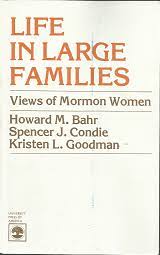Articles/Essays – Volume 18, No. 2
Bleaker by the Dozen? | H. M. Bahr, S. J. Condie, and K. Goodman, Life in Large Families: Views of Mormon Women
“Today,” said the teacher, “we have a special activity. We’re going to have a survey and find out how many brothers and sisters we all have.” One little girl from an LDS family of six children be came the object of cutting questions and negative comments after class.
The incident provoked a family crisis, and the child became ill. Her mother said, “You know, they were asking her [questions] like she was some kind of really weird, awful person and she came home and vomited and was really, really upset. We spent a lot of time with her. I thought that we had resolved the problem but the next day she came home and said, ‘Guess what? The teacher did that in all the classes and I wasn’t the worst one. There was one that had eight'” (p. 35).
There is no question that Life in Large Families is fascinating and thought provoking. Such memorable stories draw the reader into the book on both an emotional and intellectual plane. Bahr, Condie, and Goodman have done a masterful job of detailing life with a twenty-four-hour-a day baseball team. Chapters on women’s roles and the self-perceptions of the mothers, stress and depression, the marital relationship with an ever-present audience, the financial considerations of feeding a small army three times a day, and the elusive search for purpose in life, recreate the social realities of living in large families in the 1980s.
The reader from a large family will likely find validation; the reader from a small family will be incredulous. Commented one mother: “I don’t think there will ever come a time when I won’t want a baby. I think there has got to come a time when I’ve got to face that fact that there won’t be any more babies at our house, and I’ve shed a few tears over that” (p. 56).
The work not only has obvious scientific value, it presents a qualitative, interview-based alternative to the usual dry statistics of the quantitative approach. More than that, large families have typically received bad press in both scientific and lay literature. For example, most correlation based conclusions identify such dysfunctional correlates of large families as low parent-to-child affect, low child self-esteem and IQ, lower family education, income difficulties, and so on. Life in Large Families presents quite a different picture.
The relevant variable which explains the extreme range of findings related to large families may well be the theological bases for the fertility decisions rather than the methodology employed to investigate them. Indeed, the chapter on the impact of religious beliefs is the heart of the book. But it is also in the book’s treatment of these religious beliefs that some concerns arise. Two such concerns stand out in my mind.
First, the religious convictions of the mothers interviewed and the philosophical value of those positions are highly personal and intimate. The verbatim quotations often represent fragments of theological thought that are snatched from a vast and complex fabric of religious dogma. To examine these highly personal beliefs out of context — as if they were anthropological oddities — may do both the mothers and the beliefs a serious disservice. These brief and isolated scraps of dogma, ex pressed by sometimes inarticulate respondents, sound trite and silly when viewed from an outsider’s perspective. I found myself, on the one hand, wanting to laugh at some of their statements, and at the same time, to come rushing to their defense.
Second, undergirding this and similar projects is the assumption that one can effectively study one’s own beliefs — as long as the presentation wears the trappings of academic objectivity. Granted, it is not impossible for the social scientist to study his or her own personal system of thought. But it is difficult. A feminist who studies feminism, a homosexual studying the gay lifestyle, or a Latter-day Saint studying the LDS community should be doubly circumspect about his or her own value positions and not cover the issues with a detached “academic/objective” writing style. As Baumrind (1980, pp. 648- 50) has pointed out: “The last decade has seen a crisis of confidence in the logical positivist research paradigm. .. . It is not that (the) values and notions of linear causation should be dismissed as useless or absolutely false, but rather that so-called objective, logical positivist values … should no longer be permitted to dominate social and developmental research endeavors.”
I would have been more comfortable if the authors had acknowledged their own position in relation to the values discussed and had dealt squarely with the issue of investigator bias as it potentially affected the collection and presentation of the data.
But with these two concerns out of the way, I strongly applaud the authors for their frank and comprehensive treatment of a misunderstood lifestyle. Life in Large Families is well worth reading by LDS and non-LDS alike.
Life in Large Families: Views of Mormon Women, by H. M. Bahr, S. J. Condie, and K. Goodman (Washington, D.C.: University Press of America, 1982), 254 pp.


 Back to full Issue
Back to full Issue

